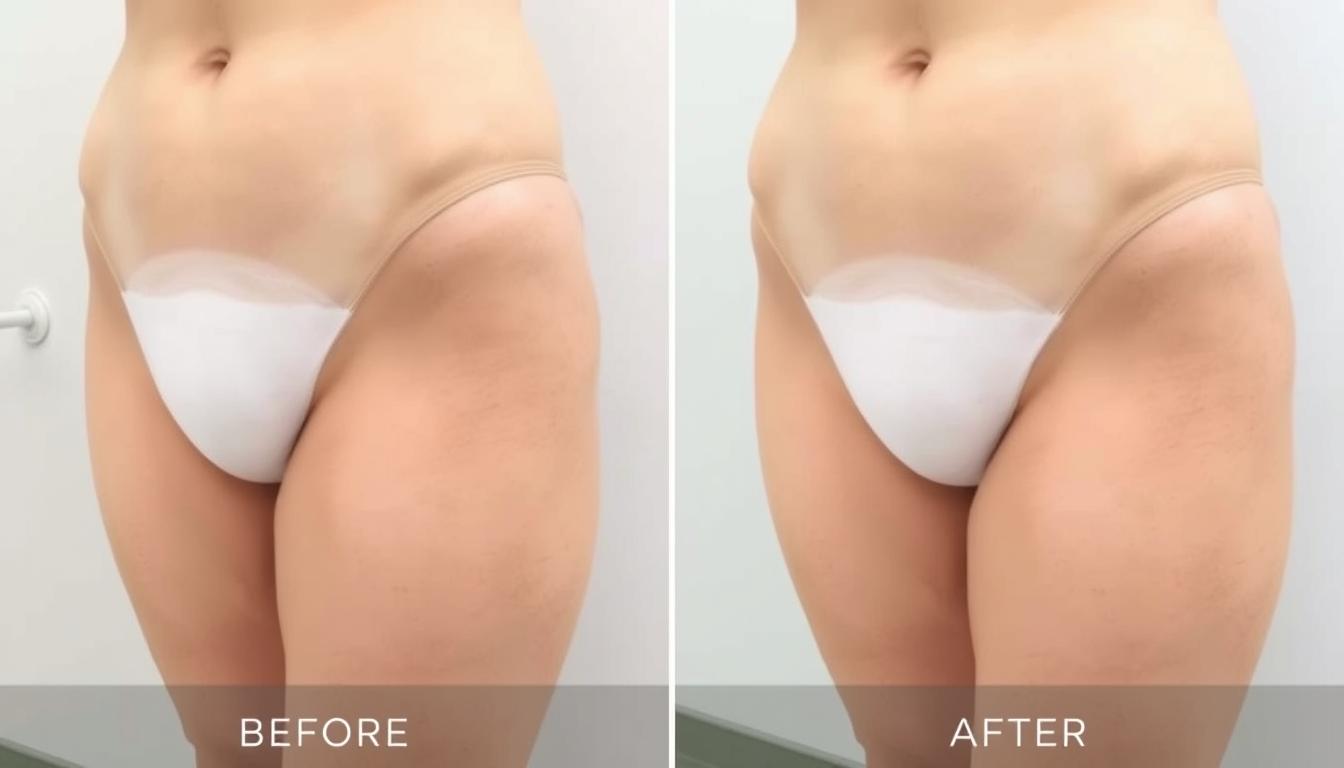Before and After Labia: Transformative Results

Did you know that 100% of labiaplasty revision cases involve patients seeking to transform their previous experiences?
Labiaplasty is a big deal in aesthetic gynecology. It aims to make the labia look better and feel more comfortable. Many women get this done to change how their labia look. This change can boost their self-confidence and emotional health.
In this article, we’ll dive into labia enhancement results. We’ll cover the procedure, recovery, and more. You’ll see real-life stories and pictures. This will help you understand what to expect before and after treatment.
What is Labia Treatment?
Labia treatment includes many surgical and non-surgical methods. These aim to reshape and rejuvenate the labia. They help with discomfort, look, and sexual pleasure. People choose labia treatment for personal reasons or to look better.
The process looks at both body and mind. It makes sure patients feel good and confident.
Overview of the Procedure
There are many labia treatments, with labiaplasty being the most common. Labiaplasty makes the labia minora smaller to match the majora. It can be done with local or general anesthesia, based on the case and patient choice.
After surgery, it’s important to rest and avoid sex for a while. This helps with healing.
Types of Labia Treatments
There are many labiaplasty types to fit each patient’s needs:
- Labiaplasty: The main surgery that makes the labia minora smaller.
- Labiaplasty Wedge Technique: Takes out a wedge of tissue for a natural look.
- Labiaplasty Trim Technique: Trims off extra tissue while keeping the natural shape.
- Labia Majora Reduction: Reduces the size of the outer labia.
- Clitoral Hood Reduction: Makes the tissue around the clitoris smaller for looks or function.
- Non-Surgical Options: Uses EmpowerRF and Votiva to tighten and refresh without long downtime.
Who Needs Labia Treatment?
It’s important to know who needs labia treatment. Many women want to feel more comfortable and confident. They seek labiaplasty for reasons that affect their daily lives.
Common Reasons for Seeking Treatment
Women have different labia enhancement reasons for getting treatment. Some reasons include:
- Physical discomfort during activities like sex, wearing tight clothes, or doing yoga. Over 50% of women feel this way.
- Pain during intimate moments, affecting nearly 48% of women. This pain often comes from labia size and shape.
- Feeling self-conscious about their labial appearance, as 94% of women do. This can make them avoid certain clothes.
Age and Demographic Considerations
The demographic trends in labiaplasty show a wide range of candidates. Patients range from teenagers to women in their 70s. Changes in labial characteristics can happen at any age, especially after childbirth.
Recognizing the need for labia treatment often comes from personal experiences. Women may feel emotional discomfort or anxiety about intimacy. They aim to regain confidence and comfort in their bodies, making this a deeply personal choice.
Understanding the Labia Treatment Procedure
The labiaplasty procedure combines various surgical methods to enhance the comfort and appearance of the labia. It’s important for those considering treatment to understand this process. It involves multiple stages, from the initial consultation to the detailed execution of the surgery.
Consultation Process
The journey toward a labiaplasty starts with a detailed consultation. During this meeting, patients share their experiences, expectations, and aesthetic goals with the surgeon. The physician then assesses the patient’s health and determines the best technique for their needs.
This step is crucial for addressing any concerns about the surgery. It ensures that patients are well-informed about what to expect.
Step-by-Step Overview of the Procedure
The labiaplasty procedure typically lasts less than two hours and is often performed as an outpatient service. Anesthesia is administered for patient comfort before the surgeon reshapes or resizes the labia. Techniques like scalpel, scissors, or laser are used.
The two primary methods for reducing labia include the trim procedure and the wedge procedure. These ensure more natural contours. For enhancing the labia majora, fat transfer or hyaluronic acid injections are available.
After surgery, patients receive detailed wound care instructions and pain management strategies. They are also given activity restrictions to promote healing. Follow-up appointments help monitor recovery, which typically allows most women to return to their normal routines within 1 to 2 weeks.
Though individual recovery may vary, it is recommended to avoid sexual intercourse for at least six weeks post-procedure. This ensures optimal healing.
| Procedure Aspect | Details |
|---|---|
| Duration | 1-2 hours |
| Recovery Time | 1-2 weeks off work, complete healing may take a couple of months |
| Techniques | Trim and Wedge procedures, fat transfer, hyaluronic acid injections |
| Post-Op care | Wound care, pain management, activity restrictions |
| Sexual Activity | Avoid for at least 6 weeks |
| Common Side Effects | Soreness, bruising, swelling lasting up to 2 weeks |
Individuals seeking a labiaplasty should maintain realistic expectations. Results develop over time as healing progresses. Engaging with knowledgeable professionals throughout the consultation process can lead to informed decisions about undertaking the labiaplasty procedure and achieving desired outcomes.
Pre-Treatment Care
Getting ready for labia treatment is key to a smooth surgery. Knowing the importance of pre-treatment care can ease worries. It helps ensure the best results. By following certain steps, you can make your recovery easier and cut down on risks.
Guidelines for Preparation
There are important steps to take before your labia treatment:
- Stop using tobacco, cigarettes, and nicotine at least 4 weeks before surgery. This helps your body heal better.
- Stick to a special diet to avoid foods and supplements that might make bleeding more likely.
- Get a medical check-up and blood tests a few weeks before your surgery.
- Follow the fasting rules, which mean no food or drink after midnight before your surgery.
- Make your home recovery area comfy with pillows, blankets, and things to keep you entertained.
Recommended Products to Use
Using the right skincare products before surgery can make your skin healthier and more resilient. This can help your recovery. Talk to your doctor about what products are best for you. Some good options might include:
| Product Type | Recommended Products |
|---|---|
| Moisturizers | CeraVe Moisturizing Cream |
| Gentle Cleansers | Neutrogena Hydro Boost Water Gel |
| Soothing Skin Care | Avene Skin Recovery Cream |
| Stool Softener | MiraLAX |
| Acetaminophen | Tylenol (as prescribed) |
Before and After Treatment Pictures
Before and after pictures are key for those thinking about labia surgery. They give a clear view of what to expect, helping set realistic hopes. Seeing the changes made by these surgeries can really help people decide.
Importance of Visual Evidence
Labia surgery pictures are very important. They let people see the changes made by treatments. These changes can make a big difference, from looking better to feeling more comfortable. Looking at these pictures helps people understand what they might get.
Where to Find Authentic Images
Finding real before and after pictures is crucial. Look for images from trusted clinics and experts in labiaplasty. Make sure the pictures are from people who have agreed to share their stories. Many clinics have big collections of pictures, showing different cases. These real pictures help people make smart choices about their surgery.
Post-Treatment Care
After labiaplasty, it’s key to follow care tips for a smooth recovery. The healing time is usually a few weeks. By following these guidelines, you can heal faster, feel less pain, and avoid complications. Good aftercare is crucial for the success of your surgery.
Recovery Expectations
Recovery from labiaplasty varies for each person. The surgery takes about 1.5 hours. You’ll need at least a week to start feeling better. Most women can get back to normal in 1 to 2 weeks.
It’s important to take care of yourself during this time. This helps avoid problems like infections or healing issues.
- Antibiotics are commonly prescribed for 5 to 10 days post-surgery.
- It is vital to avoid any sexual intercourse for at least 6 to 8 weeks to facilitate proper healing.
- Resting and avoiding vigorous activities for at least one month is recommended.
- Patients should monitor for any serious symptoms, including pronounced swelling, bleeding, or fever.
Aftercare Products to Use
Choosing the right products can make a big difference in your recovery. Here are some recommended items:
- Anti-inflammatory medications to help manage pain and swelling.
- Healing ointments to promote skin restoration and prevent scarring.
- Ice packs to reduce inflammation and discomfort.
Using these products and following the care tips can help you recover faster and get better results.
Potential Risks and Complications
Labiaplasty can greatly improve your life, but it’s important to know the risks. Every surgery has its own set of risks. It’s key to understand these before you decide to get treated.
Common Side Effects
Right after labiaplasty, you might feel some labia treatment side effects. You could experience swelling, bruising, and discomfort. These symptoms usually go away as you heal.
Keeping your area clean is very important. This helps avoid infections. Infections can lead to bleeding, scarring, and changes in how you feel.
Long-Term Considerations
Many people are happy with their labiaplasty results. But, it’s important to think about the long-term. You might need another surgery if your tissues stretch or if you’re not happy with the first results.
Going back for check-ups is crucial. It helps your doctor see how you’re doing and fix any problems. Choosing a skilled surgeon is also key. They can lower risks and make sure you get the best results.
Knowing about the complications of labial surgery helps you make better choices. Talking openly with your doctor can make your recovery smoother.
Products for Pre and Post Treatment
Using the right products is key in the healing process after labia treatments. Before and after treatment, the right skincare can improve skin health and comfort. Good skincare helps reduce swelling and makes recovery smoother.
Recommended Skin Care Products
For labia treatment, look for gentle cleansers, soothing creams, and special ointments for after surgery. Here are some top picks:
- Hydrogel Dressings: These keep moisture in.
- Moisturizing Creams: Choose ones with aloe and chamomile.
- Arnika and Bromelin Supplements: About $30 for a week, they help reduce swelling.
Importance of Using Quality Products
High-quality products are crucial after treatment. They help prevent complications as the body heals. Doctors often suggest specific products based on individual needs. Using these products ensures the skin stays hydrated.
Choosing the right products for recovery is important. Following postoperative instructions carefully helps keep the healing process on track. This leads to better results.
Alternative Treatments to Labia Procedures
If you’re thinking about making your labia look better but don’t want surgery, there are good options. These non-surgical treatments don’t leave big scars and you can get back to normal fast. They’re quick, taking just an hour to do.
Non-Surgical Options
Methods like radiofrequency labiaplasty have many benefits. You can go back to your day right after. Some women might feel a bit sore or swollen, but it’s not bad.
Since there are no cuts, you won’t have to worry about big scars. The MorpheusV and AccuTite use new tech to make your labia look better. They also help your skin and make collagen.
Lifestyle Changes to Consider
Changing your lifestyle can make your labia look and feel better. Doing pelvic floor exercises and staying at a healthy weight can help a lot. Small changes in your daily life can also help keep your labia looking good.
For tips on boosting your libido and improving intimacy, check out this article. Making these changes can really help your sex life. They work well with non-surgical treatments for lasting results.
Cost of Labia Treatments
The cost of labia treatments is a big factor for those considering them. Knowing the price helps people plan their budgets. Prices can change a lot because of different things.
Typical Price Range
The cost of labia treatments varies a lot in the United States. Prices for labiaplasty usually range from $3,000 to $10,000. This depends on how complex the procedure is and where it’s done. Here’s a look at typical costs in major cities:
| City | Price Range |
|---|---|
| New York City | $6,000 – $9,000 |
| Los Angeles | $5,000 – $9,000 (up to $25,000 in Beverly Hills) |
| Miami | $3,000 – $6,000 |
| Dallas | $3,000 – $8,500 |
| Chicago | $3,000 – $8,000 |
| Newark | $4,000 – $6,800 |
Factors Influencing Treatment Costs
Many things can affect the cost of labia surgery. These include:
- Geographical Location: Places with higher living costs tend to have pricier services.
- Surgeon Experience: More experienced surgeons usually charge more for their skills.
- Surgical Complexity: More complex procedures or those needing multiple surgeries cost more.
- Facility Fees: Costs for the operating room and anesthesia add up quickly.
- Insurance Considerations: Most insurance doesn’t cover elective surgeries, but some exceptions exist for medical needs.
Finding Labia Treatment Near Me
Finding the right specialist for labia treatment is key to getting the results you want. Start by looking online and checking out forums for local options. Reading what others have to say can help you find a good provider.
How to Research Local Providers
Here’s how to find labiaplasty providers:
- Check if the surgeon is certified and has the right credentials.
- Look at online reviews to see how happy past patients were.
- Talk to friends or family who have had the surgery.
- Check with local medical boards for any issues with the providers.
By doing this research, you can make a list of potential surgeons. Make sure they have experience with labiaplasty for the best results.
Questions to Ask During Consultation
Use your consultation to ask important questions. Here are some to consider:
- What experience do you have with labiaplasty and similar surgeries?
- Can you explain the methods you use for labial reduction?
- What are the expected results and how long will it take to recover?
- How do you handle any complications that might come up?
Asking these questions will help you understand the surgeon’s skills. It also helps you decide if you’re comfortable moving forward with the surgery.
Testimonials and Experiences
Patient experiences are key to understanding labiaplasty’s impact. Hearing real labiaplasty stories helps others see the journey. Many women share their personal experiences and outcomes.
Patient Stories
A 49-year-old woman had labiaplasty with Dr. Ashley N. Amalfi. She felt self-conscious about her labia for over 20 years. The surgery was complex but transformed her life.
She felt a lot of pain for two weeks but no bleeding after two days. She was back to normal in two weeks. She used Tylenol Extra Strength for pain.
She could sit comfortably and wear different clothes again. This boosted her confidence. Her happiness increased, as noticed by friends and family.
She found MACS Clinic exceptional. The staff was supportive. Mr. Vadodaria, her surgeon, was knowledgeable and caring. She highly recommends him.
Importance of Reviews
Reviews of labia surgery are crucial. They help assess providers and understand the procedure’s benefits. Many women get labiaplasty for comfort and beauty.
Reviews show the procedure’s impact on quality of life. By reading these, future patients can feel more confident. Labiaplasty can truly change lives.
The Role of Aftercare in Recovery
Aftercare is key for healing well after labiaplasty. It greatly affects how you feel and how your body heals. By following the right aftercare steps, you can heal faster and avoid problems.
Understanding Aftercare Importance
It’s important to follow your surgeon’s post-op instructions carefully. Keeping clean, managing swelling, and watching for signs of infection are crucial. Most people can start doing light activities in about 2 weeks.
Using the right pain meds is important for comfort. Also, taking good care of your wound helps it heal smoothly.
Follow-Up Appointments
Going to follow-up appointments is vital for checking on your healing. Usually, you’ll see your surgeon about 3 weeks after surgery. This is when you can talk about any issues and get advice.
These visits help make sure you’re healing right. They also tell you when it’s safe to start normal activities again. This is usually around 4 to 6 weeks after surgery.
| Aftercare Aspect | Importance |
|---|---|
| Hygiene | Prevents infection and promotes healing. |
| Activity Restrictions | Reduces swelling and bleeding risks. |
| Pain Management | Enhances comfort during recovery. |
| Follow-Up Appointments | Ensures proper healing and intervention if needed. |
Frequently Asked Questions about Labia Treatments
Women thinking about labia treatments often have many questions. They want to know about the procedure, recovery, and possible side effects. Answering these questions helps clear up any doubts, giving a clear picture of what to expect.
Common Inquiries
Some common questions about labia treatments include:
- What is the typical recovery time after labiaplasty?
- Will the procedure cause changes in sensitivity?
- What are the potential risks associated with labiaplasty?
Knowing these details helps women make informed choices. Many are relieved to hear that scarring is often minimal, especially with Laser labioplasty. The surgery usually requires a short stay of 2-3 days for those traveling from afar.
Expert Answers
Talking to experts can answer specific questions about pain and recovery. For example, swelling usually peaks 2-3 days after surgery. Most women can go back to their daily activities in 2-4 weeks. Plus, dissolvable stitches mean less care is needed after the procedure.
It’s important to remember that many women choose labiaplasty to feel more comfortable and confident. By looking for reliable information, women can feel more confident in their decision. For more on the emotional and psychological aspects of sexual satisfaction, check out this informative article.
Conclusion: Transformative Benefits of Labia Treatment
Labia treatment, especially labiaplasty, brings many benefits to women. It improves physical comfort and boosts self-esteem. This procedure does more than just make you look good; it also solves problems like discomfort and clothing issues.
Women who get labiaplasty often feel much better about themselves. They become more confident and start to engage more in social activities. This shows how labiaplasty can really change someone’s life for the better.
Recap of Key Points
It’s key to understand the importance of talking to a doctor before getting labiaplasty. This talk helps set clear goals and expectations. It also covers what to do before and after the surgery.
As more women in Florida and the U.S. get labiaplasty, there’s a growing acceptance of body positivity. This shows a shift towards self-improvement.
Encouragement to Seek Guidance
If you’re thinking about labiaplasty, get professional advice. This ensures you make the right choice and get the care you need. Talking to experts can help you feel better about yourself and improve your intimate health.
Labia treatment is more than just surgery. It’s a step towards feeling more confident and empowered.
FAQ
What is labiaplasty?
What are the main reasons women seek labia treatment?
What is the recovery timeline after a labiaplasty procedure?
How important are before and after pictures when considering labiaplasty?
What expected side effects should I be aware of after labiaplasty?
Are there non-surgical alternatives to labiaplasty?
What should I expect during the consultation process for labiaplasty?
What skincare products are recommended before and after labia treatments?
How do I find qualified labia treatment specialists?
What are the costs associated with labiaplasty treatments?
How significant is aftercare in the labiaplasty recovery process?
Is labiaplasty safe?






